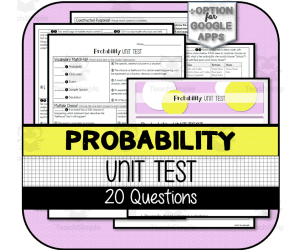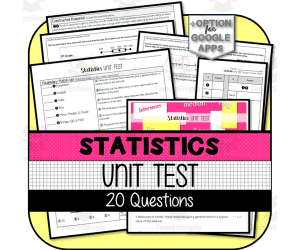2,776 products added recently
Probability Test
Probability UNIT TEST
Math, Statistics, Grade 7, Tests, Quizzes and Tests, Teacher Tools
This resource was developed to meet the requirements of the 7th Grade Statistics & Probability Standards below: CCSS.MATH.CONTENT.7.SP.C.5 Understand that the probability of a chance event is a number between 0 and 1 that expresses the likelihood of the event occurring. Larger numbers indicate greater likelihood. A probability near 0 indicates an unlikely event, a probability around 1/2 indicates an event that is neither unlikely nor likely, and a probability near 1 indicates a likely event. CCSS.MATH.CONTENT.7.SP.C.6 Approximate the probability of a chance event by collecting data on the chance process that produces it and observing its long-run relative frequency, and predict the approximate relative frequency given the probability.For example, when rolling a number cube 600 times, predict that a 3 or 6 would be rolled roughly 200 times, but probably not exactly 200 times. CCSS.MATH.CONTENT.7.SP.C.7 Develop a probability model and use it to find probabilities of events. Compare probabilities from a model to observed frequencies; if the agreement is not good, explain possible sources of the discrepancy. CCSS.MATH.CONTENT.7.SP.C.7.A Develop a uniform probability model by assigning equal probability to all outcomes, and use the model to determine probabilities of events.For example, if a student is selected at random from a class, find the probability that Jane will be selected and the probability that a girl will be selected. CCSS.MATH.CONTENT.7.SP.C.7.B Develop a probability model (which may not be uniform) by observing frequencies in data generated from a chance process.For example, find the approximate probability that a spinning penny will land heads up or that a tossed paper cup will land open-end down. Do the outcomes for the spinning penny appear to be equally likely based on the observed frequencies? CCSS.MATH.CONTENT.7.SP.C.8 Find probabilities of compound events using organized lists, tables, tree diagrams , and simulation. CCSS.MATH.CONTENT.7.SP.C.8.A Understand that, just as with simple events, the probability of a compound event is the fraction of outcomes in the sample space for which the compound event occurs. CCSS.MATH.CONTENT.7.SP.C.8.B Represent sample spaces for compound events using methods such as organized lists, tables and tree diagrams . For an event described in everyday language (e.g., "rolling double sixes"), identify the outcomes in the sample space which compose the event. CCSS.MATH.CONTENT.7.SP.C.8.C Design and use a simulation to generate frequencies for compound events.For example, use random digits as a simulation tool to approximate the answer to the question: If 40% of donors have type A blood, what is the probability that it will take at least 4 donors to find one with type A blood? LICENSING TERMS: This purchase includes a license for one teacher only for personal use in their classroom. Licenses are non-transferable, meaning they can not be passed from one teacher to another. No part of this resource is to be shared with colleagues or used by an entire grade level, school, or district without purchasing the proper number of licenses. COPYRIGHT TERMS: This resource may not be uploaded to the internet in any form, including classroom/personal websites or network drives, unless the site is password protected and can only be accessed by students.
Author The Math Cafe
Tags Probability, Unit Test, Google Forms, Probability And Statistics Unit Test Part 1
Compound Probability TASK: Guess the Test!
Math, Statistics, Grade 7, Tests, Quizzes and Tests, Teacher Tools
Compound Probability TASK: Guess the Test! This quality teaching resource targets 7th-grade Mathematics educators with specific emphasis on Statistics. The primary focus is on compound probability tasks, predominantly regarding independent events. Students are offered both entertaining and educational challenges in the guise of a multiple-choice test. Main Features Promotes diligent problem-solving: Students tackle complex compound probability issues, with calculator use strongly advised. Versatile task format: Presents three key tasks based around individual compound likelihood scenarios. Here, students learn to multiply probabilities. In-depth academic engagement: Includes challenge questions and an exploratory challenge segment to foster a deeper understanding and pull learners in. A plethora of applications: Perfect for independent study or group activities, supplemented by optional Guess the Test! quizzes to mix things up. Add-on Features: Guess the Test Dot Plots & Answer Key The 'Guess the Test Dot Plots' allows for interactive classroom discussions post-quizzes. It works by displaying number lines meant for dot plots which helps in assessing student's performance as they mark their scores corresponding to each plot followed by group discussion comparing various quiz results . An answer key is included along side these features making this product even more valuable lending precise guidelines forming correct solutions. Educational Standards Compliance & Licensing Terms This product strictly adheres to 7th Grade Statistics & Probability Standards ( CCSS.MATH.CONTENT.7.SP.C.8 ). It effectively introduces concepts through well-structured lists,tables,and simulations; comprehensive understanding of what they represent; representing sample spaces and identifying outcomes constituenting predefined event circumstances presented in a friendly language. Purchases of this resource grant usage terms that are favorable toward personal classroom use by one teacher only, indicating licenses cannot be transferred from one teacher to another providing secure and nonviolent access to this resource.
Author The Math Cafe
Tags Compound Probability, Independent Events, Multiple-choice Quiz, Calculator Use, Statistics
7th Grade Statistics UNIT TEST
Math, Statistics, Grade 7, Tests, Quizzes and Tests, Teacher Tools
About the 7th Grade Statistics UNIT TEST The 7th Grade Statistics UNIT TEST is a comprehensive tool designed to assess students’ comprehension of 7th grade statistics and probability concepts. It focuses specifically on the use of random sampling for population inferences. This assessment package, equipped with a dual format, comes in both hard copy and Google Forms versions - perfectly suited for traditional classroom settings as well as online or blended learning environments. Question Format and Distribution A variety of question formats such as vocabulary exercises, multiple-choice queries, and constructed response provisions. Inclusive of twenty questions divided into six vocabulary exercises. The distribution comprises: twelve multiple-choice queries, and two constructed responses. Eco-friendly Provisions & Quick Assessment Tools: To aid environmental-friendly practices within classrooms or homeschool environment , separate student answer sheets have been provided which works economical on printing costs. Conveniently included are answer keys with an optional scoring guide for quick assessment from educators' perspective. Effective Usage Strategies: This carefully crafted unit test can be used effectively not only in whole group settings but also serve well within breakout groups or assigned as standalone homework reinforcing key statistical principles assimilation. Proliferation & Value Proposition: With its strong accordance to 7th grade statistics & probability standards, it stands out particularly towards promoting better retention about drawing comparative differences between varied populations; estimating variability between centers by expressing multiple measured variability factors thereby inseminating useful insights. Note:- The product usage involves specific licensing terms mitigating unauthorized sharing across digital platforms without adequate licenses hence ensuring respected Intellectual property rights are diligently respected. Exclusive Access: As part of stringent safety measures, the test is password-protected thereby assuring safe access limited solely to designated students on classroom/personal websites. Make your interaction with undertaking advanced statistics explorations convenient with this thoughtfully crafted resource. The Finer Details: Specially tailored for 7th grade math curriculum making it essential for efficient teaching-learning processes. Focused on the sub-discipline of statistics – a apt addition to your teaching toolkit!
Author The Math Cafe
Tags Statistics, Probability, Assessment, Sampling, Inferences




